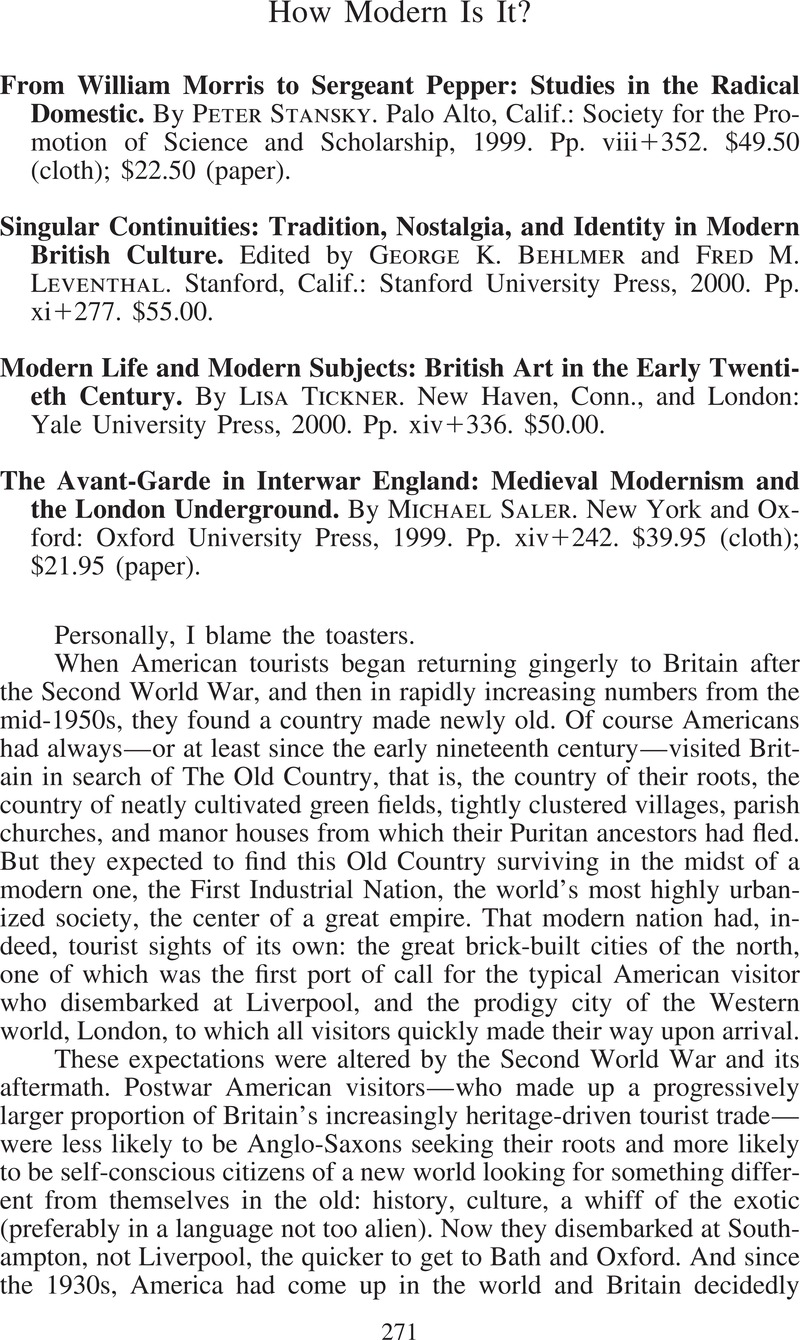Article contents
How Modern Is It? - From William Morris to Sergeant Pepper: Studies in the Radical Domestic. By Peter Stansky. Palo Alto, Calif.: Society for the Promotion of Science and Scholarship, 1999. Pp. viii+352. $49.50 (cloth); $22.50 (paper). - Singular Continuities: Tradition, Nostalgia, and Identity in Modern British Culture. Edited by George K. Behlmer and Fred M. Leventhal. Stanford, Calif.: Stanford University Press, 2000. Pp. xi+277. $55.00. - Modern Life and Modern Subjects: British Art in the Early Twentieth Century. By Lisa Tickner. New Haven, Conn., and London: Yale University Press, 2000. Pp. xiv+336. $50.00. - The Avant-Garde in Interwar England: Medieval Modernism and the London Underground. By Michael Saler. New York and Oxford: University Press, 1999. Pp. xiv+242. $39.95 (cloth); $21.95 (paper).
Published online by Cambridge University Press: 21 December 2012
Abstract

- Type
- Reviews
- Information
- Copyright
- Copyright © North American Conference of British Studies 2003
References
1 Beadle, Muriel, These Ruins Are Inhabited (New York, 1961)Google Scholar.
2 Watson, William, “The Managerial Spiralist,” Twentieth Century 167 (1960): 413Google Scholar.
3 Brown, Gordon, “Outward Bound,” Spectator (9 November 1997), pp. 15–16Google Scholar, an extract from his Spectator/Allied Dunbar Lecture, 4 November 1997. See also George Behlmer's “Introduction” to Singular Continuities, pp. 2–3.
4 Conekin, Becky, Mort, Frank, and Waters, Chris, eds., Moments of Modernity: Reconstructing Britain 1945–1964 (London, 1999)Google Scholar; Daunton, Martin and Rieger, Bernhard, eds., Meanings of Modernity: Britain from the Late-Victorian Era to World War II (Oxford, 2001)Google Scholar.
5 I say no more about them because I am a contributor to both.
6 Without stretching, one might also detect in his comment on Chaim Weizmann—that he had “the ability, rare in a foreigner, to understand the nuanced complications of British life and its special hierarchical style” (p. 303)—some understandable pride in his own ability to do the same.
7 For a criticism of this view, see Mandler, Peter, “Against ‘Englishness’: English Culture and the Limits to Rural Nostalgia, 1870–1940,” Transactions of the Royal Historical Society, 6th ser., 7 (1997): 155–75CrossRefGoogle Scholar.
8 Victorian Studies 25 (1981–82): 240–42.
9 See, e.g., the editors' introduction to Meanings of Modernity, esp. pp. 5–6, 8–12.
10 For a particularly choice example, once upon a time much quoted, see Kumar, Krishan, “The Nationalization of Culture,” in Culture and Society in Contemporary Europe, ed. Hoffmann, Stanley and Kitromilides, Paschalis (London, 1981), pp. 117–31Google Scholar.
11 Much more could be said about this excellent book, but I forbear here because I have said it elsewhere, in Twentieth-Century British History 11 (2000): 466–69.
- 3
- Cited by




